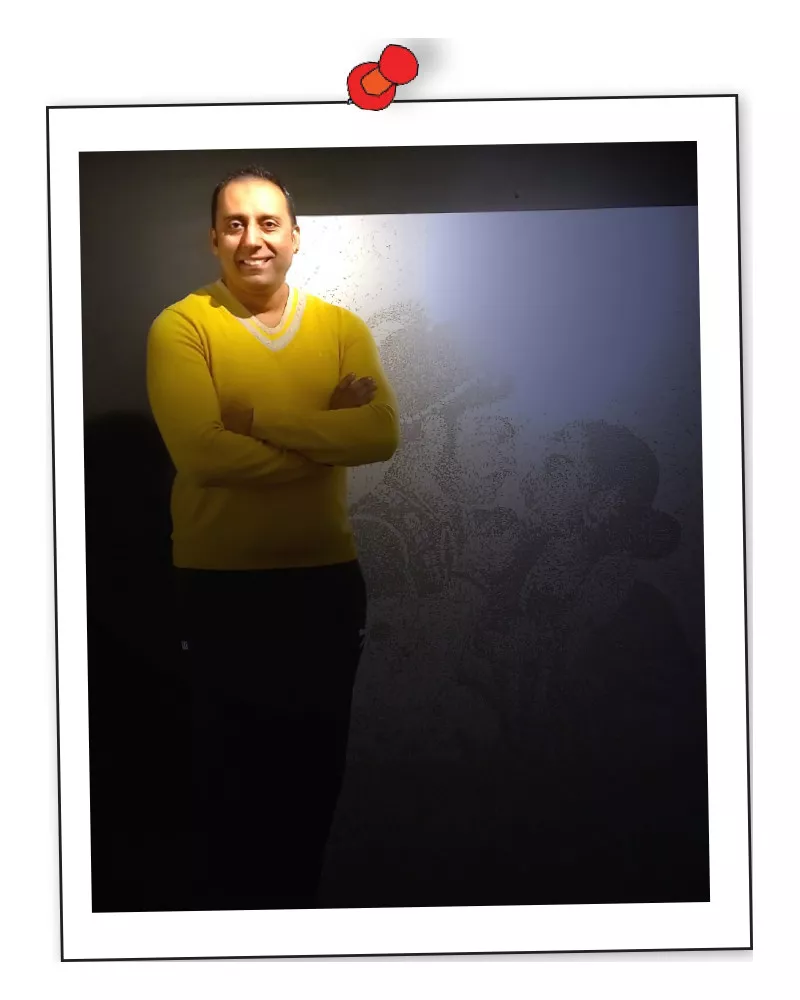The painting tradition is passed down from generation to generation in Muneer’s family. Both male and female family members begin learning the philosophy and techniques involved in creating miniatures at home, later apprenticing with master painters, from paper production to pigment mixing, calligraphy, colouring, and shading

Shiblee Muneer began calligraphy and painting apprenticeships from an early age and studied at the Naqsh School of Arts. While teaching at the Institute of Visual Arts & Design at Lahore College for Women University, Shiblee is a practicing artist who conducts workshops for children in miniature painting.
Muneer upholds the responsibility of preserving the miniature painting tradition but finds inspiration in post-modernist philosophy and new techniques: computer graphics, digitally-manipulated images, hyper-realistic painting, and collage. His experimentation with contemporary techniques within the rich canons of miniature painting earned him a spot on the list of “Asia’s 10 Most-Inspiring Visual Artists” in Top 10 of Asia magazine in 2014. Recently, he was awarded ‘Best Contemporary Painter of Pakistan’ by the prestigious art publication, Nigaah Art Awards 2023.
Shiblee, could you share a little about your art background?
I was born in Jhang into a family of artists, where miniature painting has been practised for centuries. Legend has it that our ancestors followed the first Mughal Emperor Babur from Afghanistan to Persia and then India, as part of his team of painters and calligraphers. Members of my family served at the Delhi Court until the early 19th century. With the decline of Mughal power and art patronage, they moved to Patiala, transferring the traditional Mughal technique to the Sikh-ruled court. My great-grandfather, Ustad Allah Ditta, founded the princely painting gharana at Patiala, where the ‘Pahari’ style of miniature painting developed under his guidance. My grandfather, Ustad Haji Mohammad Sharif (1889-1978), was a well-known painter in the Indian subcontinent and internationally through the UK’s India Society. After the partition of India, the family settled permanently in Lahore. Heading the Miniature Department at the Mayo School of Arts from 1945-1966, Haji Sharif developed the first curriculum for teaching miniature painting at an academic institution in independent Pakistan and trained the first cohort of miniaturists. He is considered the founder of Pakistani miniature painting.
You are famous for your miniature style of painting but have been exploring various calligraphy mediums in recent years. Which do you enjoy more?
I do not consider myself a medium-specific artist. My practice is concept-driven, and I apply mediums to stimulate my concepts while forming artworks. I enjoy the public’s reaction to my works, which gives me a deeper understanding of mediums that can be extended in future works.
What is the central concept behind your current theme?
Vision is a socialised phenomenon defined by surrounding culture. Image-making challenges and reshapes our perception of reality, serving as a powerful conduit. Through deliberate arrangements and distortions, I seek to unravel the layers between perception and reality, inviting viewers to question their visual experiences.
Tell us about the research process for your current show. How did you conceive each painting’s concept?
This body of work responds against stereotypical approaches towards us (people of the subcontinent), initiated by our invaders with commercial fibs that end up fostering an image of idiocracy to repudiate our luxurious past and entrust us with that colonial narrative. Please describe the various techniques used in the entire show. This show is a feast of image-making techniques. My diverse art apprenticeships strengthen my versatility—traditional renditions from my heritage, collage methods learned in academia, and serigraphy from my cinema billboard workshop.
Which technique is your favourite?
All techniques present specific challenges and accomplishments. Each becomes a favourite until it no longer serves the artistic solution, prompting a switch to another.
Which technique is the most time-consuming?
Traditional rendering is notably time-consuming, though collage techniques equally engage me.
The artwork you produced for the show is stunning and scandalous. Do you think people appreciate such art in Pakistan?
Art appreciation requires civility, and fortunately, my society is considered among the most civilised, appreciating scandalous stories on a global stage (as approved by Google)









COMMENTS
Comments are moderated and generally will be posted if they are on-topic and not abusive.
For more information, please see our Comments FAQ